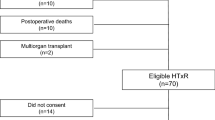Abstract
This investigation compares the cardiovascular responses of normal (n=10) and cardiac transplant (n=14) subjects to peak arm and leg exercise. It also tests the hypothesis that the higher heart rate (f c) in normal subjects during light (30 W) submaximal arm versus leg exercise is due to cardiac innervation. In cardiac transplant patients, power output, oxygen consumption\(\dot VO_2 \),f c and rate pressure product were 54%, 28%, 7%, and 8% lower during peak arm than leg exercise, respectively. In normal subjects, power output,\(\dot VO_2 \),f c and rate pressure product were 61%, 33%, 8%, and 11% lower during peak arm than leg exercise, respectively. In cardiac transplant patients there was no significant difference in absolutef c during submaximal arm and leg exercise. In normal subjects, absolutef c during arm and leg exercise was [mean (SD)] 97 (4) beats · min−1 and 92 (4) beats · min−1, respectively (P=0.07). Plasma noradrenaline was increased more during arm than leg exercise in both cardiac transplant and normal subjects. Maximal leg testing is useful when determining the capacity of cardiac transplant patients to perform arm work. The higher absolutef c reported by other investigators for normal subjects during submaximal arm versus leg exercise may be mediated by cardiac innervation.
Similar content being viewed by others
References
Allenmark S, Hedman H, Soderberg A (1980) Micro analysis of catecholamines in human plasma by high performance liquid chromatographic separation. Microchem J 25:567–572
Åstrand PO, Ekblom B, Messin R, Saltin B, Stenberg J (1965) Intra-arterial blood pressure during exercise with different muscle groups. J Appl Physiol 20:253–256
Balady GJ, Schick EC, Weiner DA, Ryan TJ (1986) Comparison of determinants of myocardial oxygen consumption during arm and leg exercise in normal persons. Am J Cardiol 57:1385–1387
Bevegard S, Freyschuss U, Strandell T (1966) Circulatory adaptation to arm and leg exercise in supine and sitting position. J Appl Physiol 21:37–46
Bunzel B, Grundbock A, Laczkovics A, Holzinger C, Teufelsbauer H (1991) Quality of life after orthotopic heart transplantation. J Heart Lung Transplant 10:455–459
Christopherson LK, Griepp RB, Stinson EB (1976) Rehabilitation after cardiac transplantation. JAMA 236:2082–2084
Davies CTM, Few J, Foster KG, Sargeant AJ (1974) Plasma catecholamine concentration during dynamic exercise involving different muscle groups. Eur J Appl Physiol 32:1195–1206
Ehrman J, Keteyian S, Fedel F, Elder R, Kataoka T (1992) Heart rate and catecholamine responses of heart transplant patients to standard and extended duration exercise tests. Med Sci Sports Exerc [Suppl] 24: S85
Fardy PS, Webb D, Hellerstein HK (1977) Benefits of arm exercise in cardiac rehabilitation. Phys Sportsmed 5:30–41
Franklin BA, Vander L, Wrisley D, Rubenfire M (1983) Aerobic requirements of arm ergometry: implications for exercise testing and training. Phys Sportsmed 11:81–90
Gleim GW, Coplan NL, Scandura M, Holly T, Nicholas J (1988) Rate pressure product at equivalent oxygen consumption on four different exercise modalities. J Cardiopulmonary Rehabil 8:270–275
Hollingsworth V, Bendick P, Franklin B, Gordon S, Timmis G (1990) Validity of arm ergometer blood pressures immediately after exercise. Am J Cardiol 65:1358–1360
Kavanagh T, Yacoub MH, Mertens DJ, Kennedy J, Campbell RB, Sawyer P (1988) Cardiorespiratory responses to exercise training after orthotopic cardiac transplantation. Circulation 77:162–171
Keteyian S, Shepard R, Ehrman J, Fedel F, Glick C, Rhoads K, Levine TB (1991) Cardiovascular responses of heart transplant patients to exercise training. J Appl Physiol 70:2627–2631
Lewis SF, Taylor WF, Graham RM, Pettinger WA, Schutte JE, Blomqvist CG (1983) Cardiovascular responses to exercise as functions of absolute and relative work load. J Appl Physiol 54:1314–1323
Marks C, Katch V, Rocchim A, Beekman R, Rosenthal A (1985) Validity and reliability of cardiac output by CO2 rebreathing. Sports Med 2:432–446
McNemar Q (1969) Psychological statistics, 4th edn. Wiley, New York, p 165
Stenberg J, Astrand PO, Ekblom B, Royce J, Saltin B (1967) Hemodynamic response to work with different muscle groups, sitting and spine. J Appl Physiol 22:61–70
Victor RG, Seals DR, Mark AL (1987) Differential control of heart rate and sympathetic nerve activity during dynamic exercise. J Clin Invest 79:508–516
Author information
Authors and Affiliations
Rights and permissions
About this article
Cite this article
Keteyian, S., Marks, C.R.C., Levine, A.B. et al. Cardiovascular responses of cardiac transplant patients to arm and leg exercise. Europ. J. Appl. Physiol. 68, 441–444 (1994). https://doi.org/10.1007/BF00843743
Accepted:
Issue Date:
DOI: https://doi.org/10.1007/BF00843743




